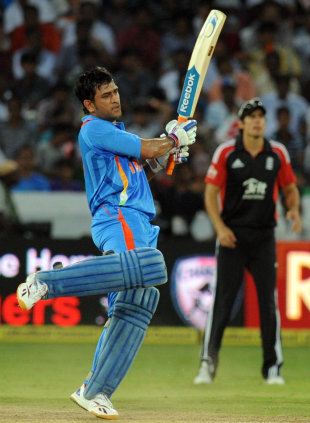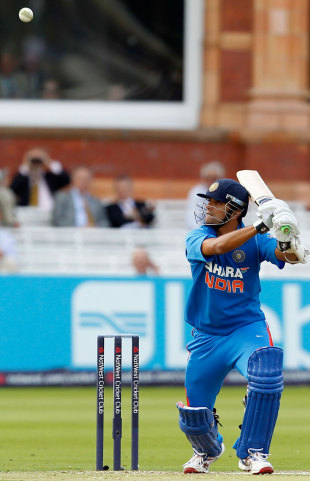Tea Australia 154 for 4 (Marsh 68*, Hussey 18*) v Sri Lanka
Live scorecard and ball-by-ball details
| 
Shaun Marsh was 68 not out at tea © AFP
|
| Enlarge |
|
| |
Shaun Marsh justified Australia's decision to keep him at No.3 with a gutsy half-century on the first day in Colombo, where Sri Lanka held a slight edge at tea. Having been sent in by Tillakaratne Dilshan, Australia had reached 154 for 4 at the break, with Marsh on 68 and Michael Hussey on 18, and their partnership was the important one for Sri Lanka to break, with only the out-of-form Brad Haddin and the bowlers to come.
However, getting through Marsh and Hussey was not proving an easy task, both men showing the sort of concentration that earned them hundreds in the Pallekele Test. Marsh especially was impressive in his composure, defending the good balls, leaving those he could, and choosing the right ones to put away.
In the final over before tea, Marsh drove a boundary straight down the ground off Suranga Lakmal, which took him to 209 runs in his first two Test innings, the most by an Australia player, passing Kepler Wessels' record of 208. He brought up his half-century from his 125th delivery with a pull for four off Lakmal, and it was typical of his innings: a bad ball, and no risk in the stroke.
His senior team-mates could have learnt something from his approach. Ricky Ponting, who moved down to No.4 to accommodate Marsh, played well for his 48 but appeared to lose concentration when he drove at a fullish outswinger from Lakmal and edged behind, while Michael Clarke's poor run of form continued, even back down at No.5.
Clarke flashed at a wide ball from Shaminda Eranga and was caught behind for 6, and it was a very unimpressive piece of batting given Australia's need to make the most of the chance to bat first. It was a surprise that Dilshan sent Australia in, but he believed the surface would provide some early seam movement due to rain in the lead-up to the game.
It was the 12th occasion a captain had sent the opposition in at the SSC, but only twice has that decision led to a victory: both times against Bangladesh. The early signs for Sri Lanka were good, with Lakmal removing Phillip Hughes for a second-ball duck in the second over. Lakmal angled the ball across the left-hander and straightened it just a fraction off the seam. The ball caught the inside edge of the bat as Hughes wafted aimlessly away from his body, and the stumps were rattled.
It was a disappointing effort from Hughes, who is viewed by the selectors as the long-term opening partner for Shane Watson but has not reached fifty in any of his past ten Test innings. Shane Watson is also experiencing an uncharacteristic lean patch, and that continued when on 8, he drove hard at a full and wide delivery from Eranga and was snapped up at backward point.
It was a joyous moment for Eranga, who became the second Sri Lankan to take a wicket with his first ball in Test cricket, after Chamila Gamage in 2002, and the second man to achieve the feat in this series after Australia's Nathan Lyon. The inclusion of Eranga was one of a raft of changes to Sri Lanka's line-up for this Test.
The left-arm spinner, Rangana Herath, was included after missing the Pallekele Test due to a finger injury, and the Sri Lankans went for a more seam-heavy attack by dropping the spinners Suraj Randiv and Seekkuge Prasanna. They also axed the veteran batsman Thilan Samaraweera and brought in Lahiru Thirimanne, who will open, while Dilshan will move down to No.5.
But first, they need to get through the rest of Australia's batting order. And against an in-form Marsh and Hussey, that could be easier said than done.













